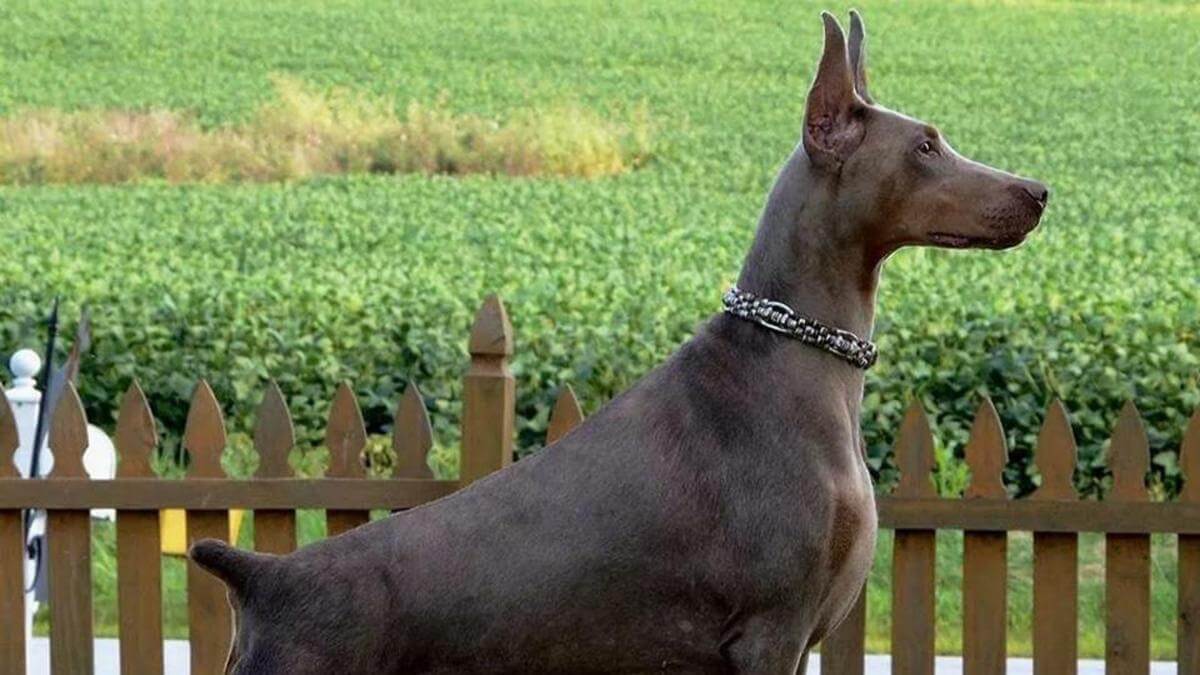


Home » The Doberman Pinscher By Your Side

This article was originally published in Showsight Magazine, September 2013 issue.
The Doberman Pinscher is an American hero and good citizen. Dobermans served in WWII as sentries, messengers, and scouts for the U.S Marine Corps in the Pacifc. Tey explored caves, detected mines, revealed booby traps and hiding enemy soldiers, protected sleeping soldiers in foxholes, carried messages and medicine, and warned of upcoming attacks. Always Faithful, pictured below, is a memorial statue of Kurt, a Doberman who lost his life in battle after silently warning troops of an upcoming attack by 5,000 enemy soldiers. When Kurt was badly wounded, his handler, Private 1stClass Allen S. Jacobson was also injured, but refused treatment until Kurt had been carried to the veterinarian. Kurt represents the 25 heroic Marine War Dogs who gave their lives in courageous service, with love, devotion, and valor, during the War in the Pacifc. Te Doberman Pinscher was developed in Germany by Karl Friedrich Louis Dobermann in the late 19th century for protection and companionship. Te Doberman continues to be treasured by owners as the Breed who protects and connects with their people. Dobermans thrive with owners committed to a dog/owner team of mental and physical challenges, i.e. performance and working dog sports, Search and Rescue, and an array of good citizen therapy jobs. Shirley Hammond and her Search and Rescue Doberman, Sunny, are pictured on next page assisting at Ground Zero following the 9/11 attack on the World Trade Center.
Sunny was trained to search for survivors. Doberman/owner teams also provide emotional and comfort therapy in many diferent types of good citizen therapy jobs, such as visiting hospitals and nursing homes and in children’s reading programs, pictured on next page. Another Doberman Good Citizen team is Sandy Driscoll and her Doberman Gunner, whose registered name is CH Dymon’s Above Te Law Winmar ROM, CD, TD, CGC. Gunner earned his Championship by 2 years old, passed the Working Dog Evaluation (WAE), competed in obedience for over 4 years, and then earned his Terapy Dog Certifcate from Terapy Dog International (TDI) http://www.tdi-dog.org/. Since then, Sandy and Gunner, now almost 12 years old, have worked in a residential care and treatment facility for abused, abandoned and neglected boys. Gunner has helped many children, but none more than one severely troubled boy who Gunner has been working with for the past 6 years, from when Johnny was 9 years old. An example of Gunner’s positive impact on Johnny, was the boy’s 13th birthday. Johnny had been very sad and incommunicative for some time, and was now curled up in a ball in his room. He would not get up even when Gunner got on his bed and nuzzled him gently with his nose.
Te therapist suggested they leave Gunner alone with Johnny and Sandy agreed. Tey left Gunner and his toys, brush, treats, and a birthday gift for Johnny in the room and went just outside the door. It was quiet for a few minutes. Tey waited. Ten came the sound of Johnny sitting up in the bed with Gunner, then toys squeaking and Johnny’s laughter. Finally, Johnny and Gunner came running out of the room together. Te staf began to cry. Everyone had cake, including Gunner, sang Happy Birthday, and was blessed to witness a young boy enjoying his 13th birthday with his best friend. Gunner and Johnny developed a relationship of trust, through unconditional love, ultimately enabling this now 16 year old boy to move to a new group home with hope for continued improvement. Clinicians told Sandy the boy is doing well longterm and attributes much of his progress to his relationship with Gunner. Sandy was aware of Gunner’s potential for therapy work since he was a young dog. Te TDI test and evaluation confrmed her belief and provided additional guidance in identifying his particular aptitude with children. Sandy stressed not every dog can or should pursue therapy dog service. A dog must be well-socialized and have mastered basic training. He or she must be confdent, friendly, and outgoing with adults and children, and never shy or aggressive in any way.
A solid temperament is essential to work with people with serious emotional issues and in an environment of unanticipated loud noises, intimidating medical equipment, and other experiences the average dog does not encounter. Sandy recommended owners interested in getting started in therapy work go to the TDI website, http://www.tdi-dog.org/, to learn how. Sometimes the best relationships happen when we aren’t looking for one. Such was the case with longtime Doberman obedience competitor and Judge Don Levinson. Trough a friend, Don was introduced to a Doberman who was looking for her forever home. She had been rehomed twice before, but this time it was love at frst sight, for both Don and Casha. Don remarked, “Sometimes a dog and an owner are a perfect ft.” As a number of Doberman owners have experienced, this was Don’s frst step in a forever partnership with his once in a lifetime Doberman, and the Breed. Upon meeting Casha for the frst time, Don’s wife had a considerably diferent reaction. She was petrifed of the new arrival and insisted Don get Casha in training immediately. Don began to train with an all breed training club. “Te more I trained her, the more she trained me,” he recalled. Teir bond became stronger and stronger. Tey began to compete in obedience, ultimately earning a UD for this frst time Doberman owner and his partner.
Don has continued in obedience with his subsequent Dobermans and became an AKC Obedience judge and trainer volunteer at the training club where he and Casha began. He and the spirit of Casha continue to give back to those of us who, like him, enter that frst training class with our new Doberman, unaware of where this new relationship and partnership will lead. Tere are no short cuts with a Doberman. Although they are each as diferent as people are, they all require a great deal of time and commitment to be properly socialized with people, dogs, and the environment as well as learn basic manners and commands. Don cautioned they are not the right dog for everyone. An intelligent, energetic, and powerful working Breed, the Doberman requires signifcant physical and mental exercise. Tey cannot be penned up or left alone to entertain themselves. Dobermans are high maintenance dogs in terms of personal contact time with their owners, and have earned the nickname Velcro dogs, as they are relationship driven and need to be with their people. To illustrate the challenge of owning a Doberman, Don spoke of a young couple in the Marine Corps with two young children who added a stable, well bred Doberman to the family.
Despite the Doberman’s good temperament, his natural exuberance and size, combined with the couple’s lack of time to socialize and train him, proved too much and the couple asked the breeder to take him back, which the breeder willingly did. As with Don and Casha, a Doberman owner must be prepared to commit the time to socialize and train together, and ideally build a partnership in classes and club activities, i.e. showing, agility, obedience, and tracking. An owner/Doberman team can also get involved in therapy work or one of the many good citizen activities that best suits the Doberman and, secondarily, the owner. Additionally, Don noted the importance of being aware of your Doberman’s temperament and fnding the basic training method that works best for your dog, even though it may not be what you have previously used. “Just like people, no two Dobermans are alike. Some are softer and more sensitive and get their feeling hurt, while others can take a more strong correction. Each has a diferent temperament and needs to be trained accordingly. Training methods that work for one Doberman, may not work for another.” When Casha and Don competed in obedience, people showing in Breed advised him to show her. Members of the DPCA Chapter Club Don had joined helped mentor him through the process of getting her ready for showing and in fnding the perfect handler.
Casha handily earned her CH, including a BISS from the Veteran Class. New Doberman owners would be wise to join and become active in their local Doberman Pinscher Club of America (DPCA) Chapter Club, http://dpca.org/club/DPCA_chapterclubs.htm. Te collaborative environment that helped Don in 1973 is still a viable information resource today in helping a new owner and his/her Doberman learn and grow as a team. When Vic Monteleon held one of the frst Working Aptitude Evaluations (WAEs) http://dpca.org/awards/wae/ on the East Coast, Don and Casha entered. She passed. At this point in our interview, Don paused as he looked for the date on her framed Working Aptitude Certifcate, still hanging in a place of honor on his wall. On Aug 13, 1978, CH Casha von Meyersdorf CDX (at that time) WAC became one of the earliest Register of Merit Certifed Dobermans (ROMs). Casha had one litter and lived 14 years. Don has shared his life with two of her pups, two other Doberman companions who excelled in obedience, and a beautiful male Doberman who had to be put down due to an unstable temperament. Currently, Don shares his home in Alexandria, VA with Eve, a 10year old female who had six UDX legs when she retired, and CH Kerwynd’s Burning Love CD, call name Lava. Don said each was so diferent and he’s “loved every one of them”. Whether the Doberman is a Marine War Dog, redeeming force for a troubled boy, partner in therapy work, search and rescue, or performance sports, our Dobermans are by our side. Te Doberman is a dog who needs a working partner and life companion. Tey need a job and they need to do it with you. Once by your side, working together, your Doberman will be there forever.